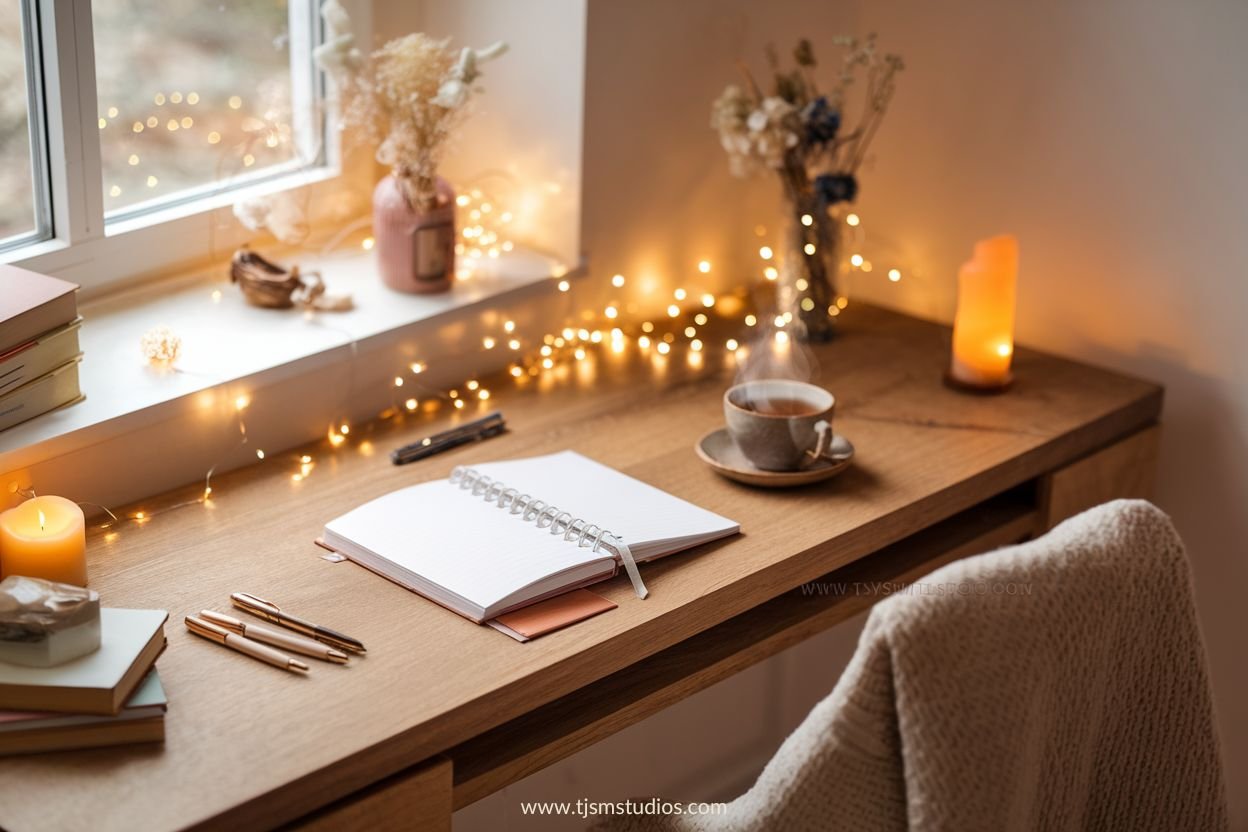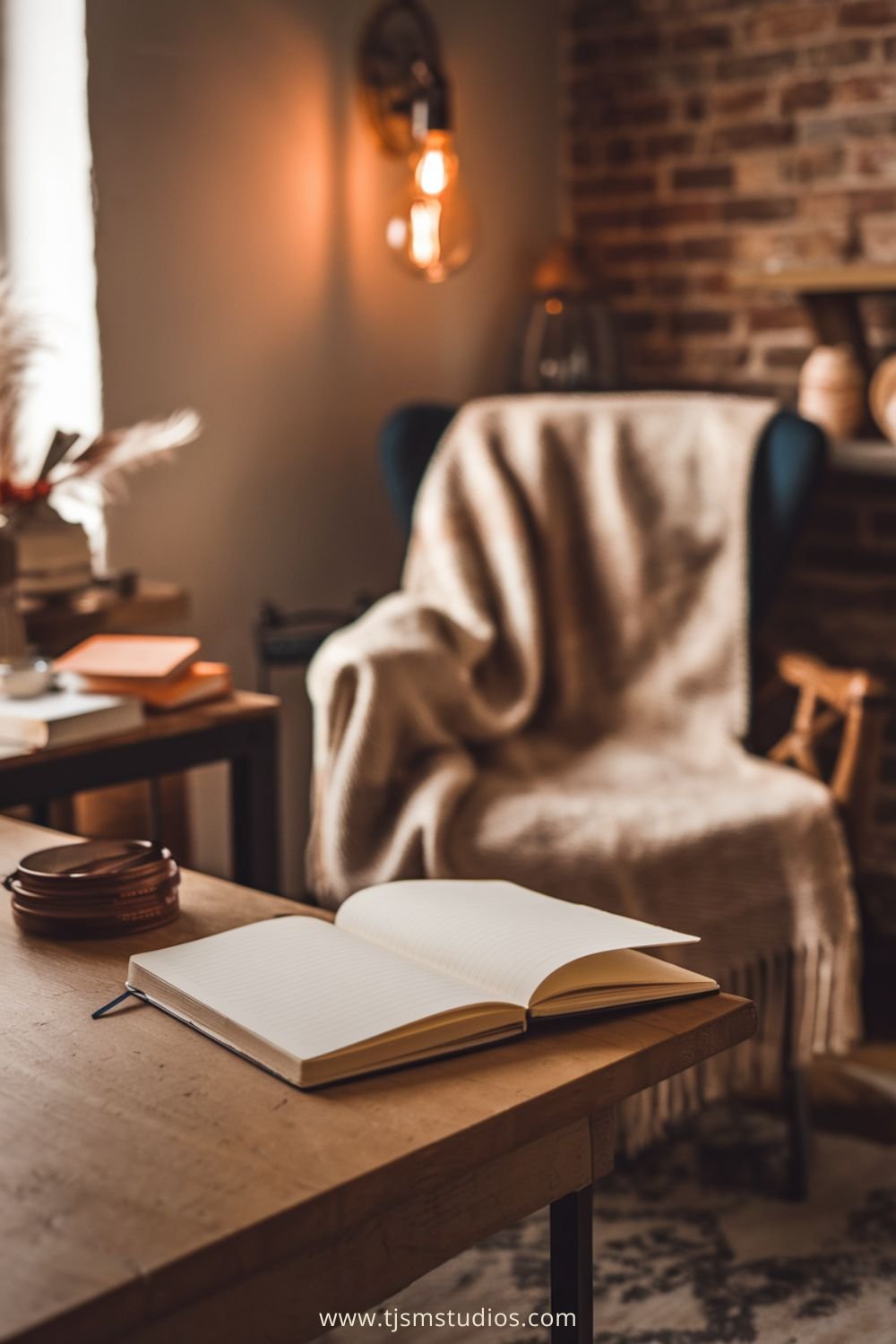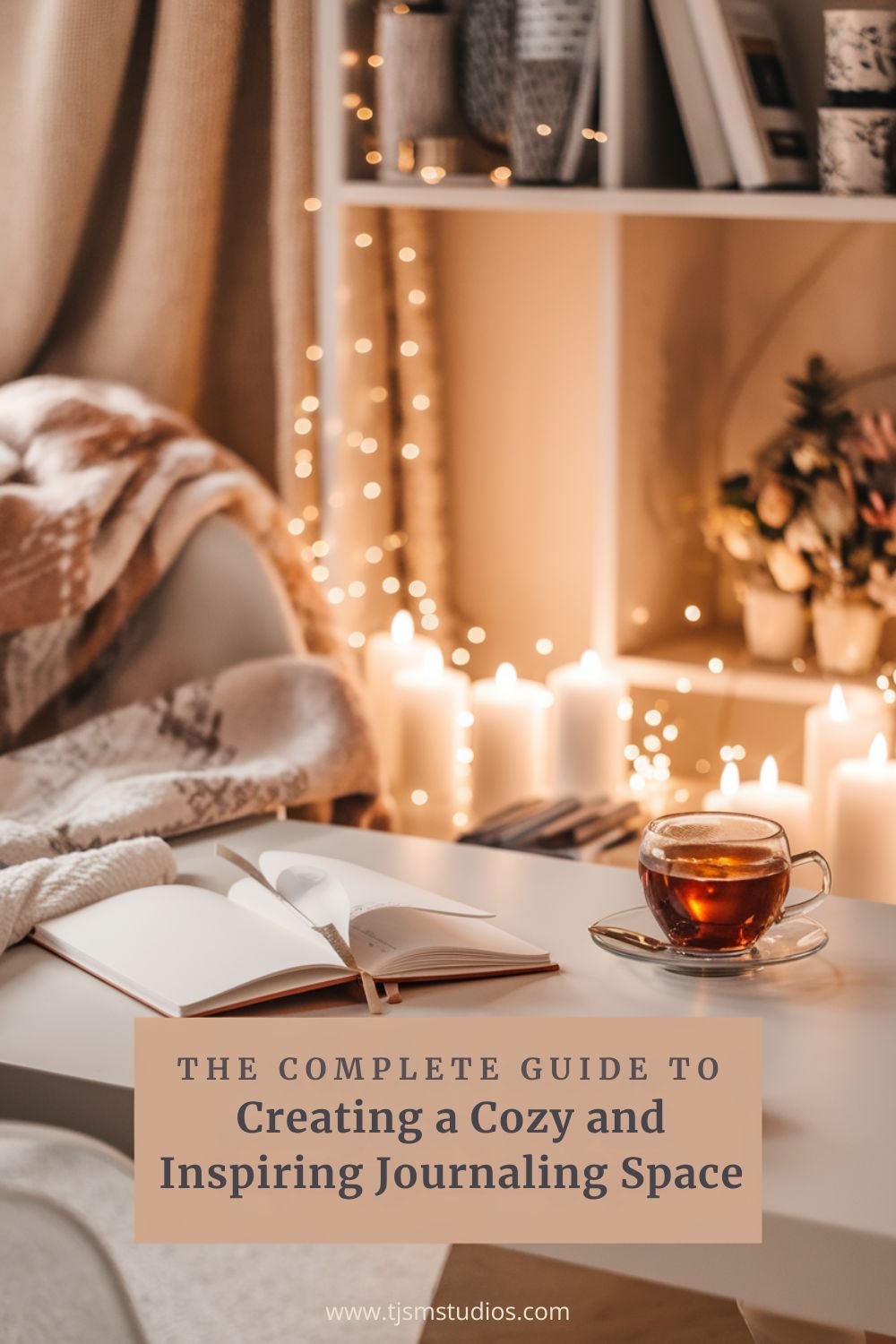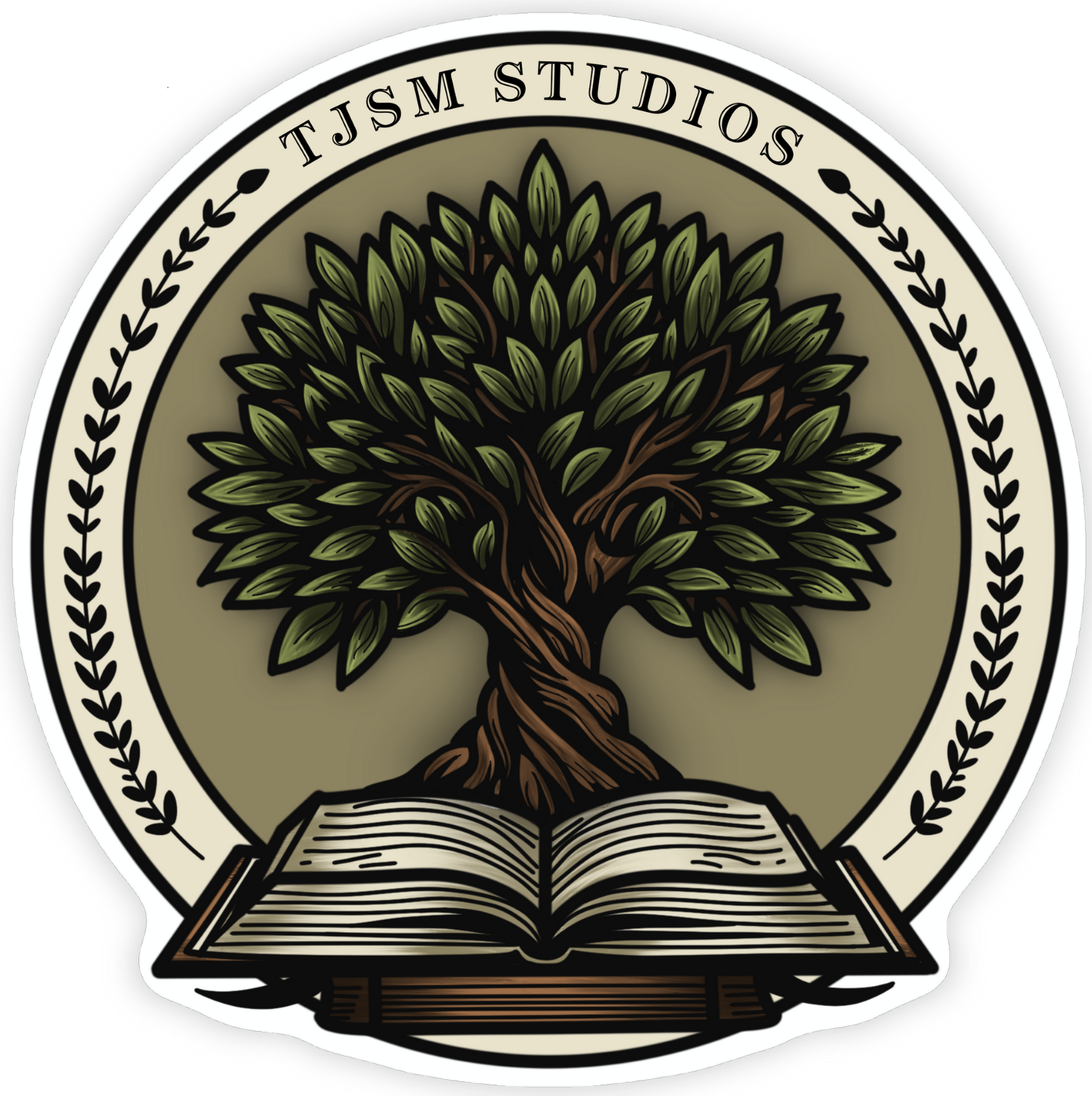This post may contain affiliate links, meaning I may earn a small commission at no extra cost to you.

Journaling is a deeply personal and enriching activity that goes far beyond simply writing down words. It’s a voyage of self-exploration, a canvas for creativity, and a sanctuary for mindfulness. As eloquently expressed by author Anne Lamott, “Almost all my middle-aged adult life, I have been a journaler,” highlighting the transformative power of journaling over time. Whether you’re seeking to capture fleeting thoughts and emotions, generate innovative ideas, or cultivate a sense of inner peace, having a dedicated space for your journaling practice can elevate the experience to new heights.
This comprehensive guide will take you on a journey to create a journaling space that transcends the ordinary. It will not only serve as a wellspring of inspiration for your creative expression but also foster an environment of relaxation and focus. By incorporating elements that resonate with your personal style and preferences, your journaling area will become a cherished haven where you can freely explore your thoughts and emotions.
A thoughtfully designed journaling space can have a profound impact on your overall well-being. It can transform your journaling practice from a sporadic activity into a treasured ritual that seamlessly integrates into your daily life. By creating an environment that nurtures your mind, body, and soul, you’ll find yourself naturally drawn to your journaling sanctuary, eager to embark on new adventures of self-discovery and creative expression.
Assessing Your Needs
Understanding Your Journaling Style
Before you start designing your space, it’s crucial to take a moment to reflect on your personal journaling style. This introspection will be invaluable as you curate a space that truly supports your practice. Ask yourself: Are you more inclined towards reflective journaling, where you delve deep into your thoughts and feelings, exploring your inner world? Or do you find yourself drawn to creative journaling, where your pages are filled with doodles, sketches, and other artistic expressions? Perhaps you enjoy a blend of both styles, allowing your journal to be a canvas for both introspection and creativity.
Additionally, consider the frequency of your journaling practice. Do you find solace in writing daily, using your journal as a confidante for your thoughts and experiences? Or is your journaling more of an occasional practice, reserved for moments of inspiration or reflection? Understanding the rhythm of your journaling will help you design a space that accommodates your needs, whether it’s a dedicated nook for daily writing or a cozy corner that beckons you when the mood strikes.
Identifying Your Space Requirements
Next, take a practical look at your living space and identify potential areas for your journaling sanctuary. Do you have the luxury of a spare room that you can transform into a dedicated journaling haven? Or will you be carving out a cozy corner in your bedroom, living room, or home office? If space is limited, consider creative solutions such as a lap desk that allows you to journal comfortably anywhere or a rolling cart that can be tucked away when not in use.
Regardless of the size of your space, prioritize privacy and comfort. Your journaling area should be a place where you can immerse yourself in your thoughts and feelings without distractions. Ensure that you have adequate lighting, whether it’s natural light from a window or a well-placed lamp that illuminates your pages. Consider the ergonomics of your seating and writing surface to prevent discomfort during extended journaling sessions. And don’t forget the importance of ambiance – soft music, scented candles, or calming décor can all contribute to a serene and inspiring atmosphere.

Choosing the Right Location
Ideal Spaces for Journaling
The best journaling spaces are those that resonate with you and inspire you to put pen to paper.
Here are a few ideas to get you started:
- Home Office: A dedicated workspace can help you focus and minimize distractions, allowing your thoughts to flow freely.
- Bedroom: A cozy nook in your bedroom can create a peaceful and intimate atmosphere, perfect for reflection and introspection.
- Cozy Corner: Transform a small, unused area of your home into a dedicated journaling space. A comfortable chair, a small table, and a few personal touches can create a haven for your thoughts.
- Outdoor Spaces: If weather permits, consider journaling in a peaceful outdoor space, such as a porch, patio, or garden. The sights and sounds of nature can spark creativity and provide a sense of calm.
- Coffee Shops and Cafes: The ambient noise and bustling atmosphere of a coffee shop can be surprisingly conducive to journaling for some.
- Libraries: The quiet and scholarly atmosphere of a library can be a great place to focus and delve deep into your thoughts.
Factors to Consider When Selecting Your Journaling Location
When selecting your ideal journaling location, pay attention to the following factors:
- Natural Light: A well-lit space can boost your mood, enhance your focus, and spark creativity. If natural light is not available, consider using full-spectrum lamps to mimic sunlight.
- Noise Levels: Choose a quiet area to minimize distractions and allow your thoughts to flow uninterrupted. If you can’t find a quiet space, consider using noise-canceling headphones or earplugs.
- Comfort: Ensure your journaling space is comfortable and inviting. A comfortable chair, a supportive cushion, and a soft blanket can make a big difference in your journaling experience.
- Accessibility: Ensure your journaling space is easy to access whenever inspiration strikes. Keep your journal and writing tools readily available, so you can capture your thoughts whenever they arise.
- Personal Touches: Add personal touches to your journaling space to make it feel inspiring and inviting. Photos, artwork, plants, and other decorative items can create a space that reflects your personality and enhances your creativity.
- Organization: Keep your journaling space organized and clutter-free. A tidy space can help you focus and prevent distractions.
Remember, the most important thing is to find a space that feels right for you. Experiment with different locations and see what works best. Your ideal journaling space may change over time, so be flexible and adaptable.
Essential Elements of a Journaling Space
Furniture and Layout
Your furniture should be both functional and comfortable, creating a space where you can settle in and focus on your journaling. Consider the following options:
- Desk or Table Options: A sturdy desk provides a dedicated writing surface and can accommodate a laptop, books, and other supplies. If you prefer a more flexible option, a small table can be easily moved around to find the perfect spot for your journaling session.
- Comfortable Seating Choices: A cozy chair with good back support will keep you comfortable during long journaling sessions. A bean bag offers a more relaxed option, perfect for curling up with your journal. If you like to switch positions, consider a floor cushion or a rocking chair.
- Lighting: Ensure adequate lighting to avoid eye strain. Natural light is ideal, but a desk lamp with adjustable brightness can also be used. Consider the color temperature of your light bulbs, as warmer tones create a more relaxing atmosphere.
Storage Solutions
Keeping your journaling supplies organized is essential for maintaining a clutter-free environment that encourages creativity. Here are some storage solutions to consider:
- Shelves or Baskets: Use shelves to display your favorite journals, books, and decorative items. Baskets can be used to store pens, markers, stickers, and other supplies.
- Drawer Organizers: Drawer organizers are perfect for keeping smaller items like paperclips, washi tape, and stamps neatly sorted.
- Rolling Carts: A rolling cart can provide additional storage space and can be easily moved around to suit your needs.
- Pegboards: A pegboard can be used to hang frequently used items like scissors, rulers, and sticky notes.
Personal Touches
Add elements that inspire you and reflect your personality to make your journaling space truly your own. Here are some ideas:
- Plants: Plants add a touch of nature and can help to purify the air. Choose plants that are easy to care for and that thrive in indoor environments.
- Art: Hang inspiring quotes or artwork that resonates with your journaling journey. You can also display your own artwork or photographs.
- Candles or Diffuser: A scented candle or diffuser can create a calming atmosphere and enhance your journaling experience. Choose scents that you find relaxing and uplifting.
- Crystals: Some people find that crystals can help to promote focus and creativity. Choose crystals that you are drawn to and that have properties that align with your intentions.
- Music: Soft instrumental music can help to create a peaceful atmosphere and drown out distractions.
- Blankets and Pillows: Add a cozy blanket and some pillows to create a comfortable and inviting space.
Remember, the most important thing is to create a space that feels good to you and that inspires you to write. Experiment with different elements until you find what works best for you.

Creating an Inspiring Atmosphere
Color Schemes and Lighting
The colors you choose for your journaling space can significantly impact your mood and focus. Opt for calming colors like soft greens, blues, or earthy tones to create a serene and inviting atmosphere. These colors promote relaxation and can help you clear your mind before you start writing.
Good lighting is essential for any workspace, and your journaling space is no exception. Consider a desk lamp with adjustable brightness to ensure you have adequate lighting for those late-night journaling sessions. Natural light is also beneficial, so if possible, position your journaling space near a window.
Incorporating Nature
Bringing nature into your journaling space can have numerous benefits. Plants not only beautify your space but also improve air quality and promote relaxation. The presence of greenery can also help you feel more connected to nature, which can be inspiring for your writing. Consider low-maintenance options like succulents, peace lilies, or air plants.
If you don’t have a green thumb, you can still incorporate nature into your space in other ways. Consider adding natural elements like stones, shells, or driftwood to your decor. You could also hang nature-inspired artwork or photographs on the walls.
Sound and Scent
Sound and scent can play a significant role in creating a calming and inspiring atmosphere for your journaling practice. Enhance your journaling experience with soothing music or nature sounds. Consider using a white noise machine or playing instrumental music to create a peaceful ambiance.
Aromatherapy can also be a powerful tool for relaxation and focus. Use essential oils like lavender, eucalyptus, or chamomile in a diffuser to create a tranquil atmosphere. You could also light scented candles or use incense to add a pleasant aroma to your space.
Remember, the goal is to create a space that feels inviting and inspiring to you. Experiment with different colors, lighting, sounds, and scents until you find a combination that helps you relax and tap into your creativity.
Tips for Maintaining Your Journaling Space
Regular Organization
Keeping your journaling space tidy and inviting by regularly organizing your supplies is essential for a productive and enjoyable experience. A cluttered environment can be distracting and overwhelming, making it difficult to focus and find the supplies you need. Dedicate time each week or month to declutter your space, putting away any unused supplies and organizing the rest in a way that makes sense for you. Utilize drawers, shelves, bins, or other storage solutions to keep everything in its place.
Seasonal Refreshes
Updating your decor and supplies to match the seasons can breathe new life into your journaling space and keep it feeling fresh and inspiring. As the seasons change, consider swapping out your color scheme, adding seasonal decorations, or incorporating new elements that reflect the current season. For example, you could add warm colors and cozy textures in the fall, bright colors and floral accents in the spring, or calming blues and nautical touches in the summer. These simple changes can make a big difference in how your space feels and can help to spark new ideas and creativity.
Setting Boundaries
To ensure your journaling space remains a personal retreat where you can focus and reflect, it’s important to set clear boundaries with others. Communicate your need for uninterrupted time in your space, and let them know when you’re not available for interruptions. Consider establishing specific times for journaling and making it clear that during those times, you’re not to be disturbed unless it’s an emergency. You may also want to physically separate your journaling space from other areas of your home, if possible, to create a clear distinction between your personal retreat and the rest of your living space.
Conclusion
Creating a cozy and inspiring journaling space is a rewarding endeavor that can enhance your writing practice. By assessing your needs, choosing the right location, and incorporating essential elements, you can design a space that nurtures your creativity and mindfulness.
We’d love to see your journaling spaces! Share your photos or tips in the comments below.

